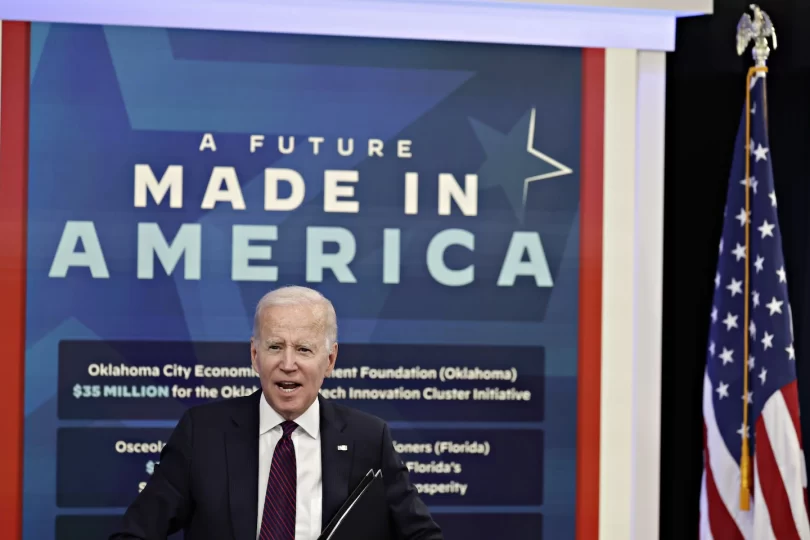[ad_1]
That’s why it’s often misleading to measure job creation by presidential term — an artificial metric beloved by presidents and the public alike.
When we saw this tweet, we immediately thought “coronavirus.” The global pandemic that emerged early in 2020 destroyed millions of jobs, though some rehiring began almost immediately. Almost 1.4 million manufacturing jobs were lost from February to April, according to the Bureau of Labor Statistics, but then 233,000 were regained in May. By the time Biden took office in 2021, the number of manufacturing jobs in February was about 560,000 below the level of a year earlier — meaning more than 800,000 had been regained before Donald Trump left office.
The United States finally returned to the pre-pandemic level of manufacturing jobs in June of this year. Biden undoubtedly would credit passage of his coronavirus relief package in March 2021 as providing the necessary spark. But major relief packages were also passed under Trump, illustrating why it’s so hard to credit any single president for job gains under his watch. About 525,000 of the restored jobs came after passage of Biden’s covid relief bill, smaller than the number recovered under Trump.
This chart of BLS data, via the Federal Reserve Bank of St. Louis, puts the manufacturing job gains in context. It shows a pretty steady gain since June 2020, though the gains briefly started to flag in April 2021, indicating that Biden’s covid relief package might have helped restore some momentum.
Now, with that context in mind, let’s look at Biden’s tweet: “Right now, I have the strongest record of growing manufacturing jobs in modern history.”
When we first saw the tweet, we assumed that he was comparing 19-month periods of different presidents. Under Biden, about 630,000 manufacturing jobs have been gained, or 5.2 percent, from February 2020 to August 2021.
That’s a pretty good record, but it was topped by Richard M. Nixon. From February 1972 to August 1973, more than 1.3 million manufacturing jobs were added, or 7.6 percent. Given that Biden was a senator back in 1972, we would have thought this was still “modern history.”
But it turns out Biden was not making this comparison at all. Instead, he was talking about the monthly job-creation average over the entire presidencies. Note this White House chart making the point in more detail.
This is a strange way to do it. It mixes the records of presidents who served one or two terms — or less. Biden of course has not yet served two years, meaning he has far fewer months to divide into the total. A lot could change in the next two-plus years — which is apparently why the tweet includes the phrase “right now.”
Interestingly, Trump played the same game. In his 2020 State of the Union address, just before the coronavirus tanked the economy, he claimed: “Incredibly, the average unemployment rate under my administration is lower than any administration in the history of our country.” Trump was also comparing his uncompleted term to the four- or eight-year average for other presidents.
His line brought bad karma. Within weeks, the economy collapsed and unemployment soared, rendering his claim incorrect.
We also find it ironic that the White House chart depicts Barack Obama as a manufacturing-job loser. During the Obama administration, when Biden served as vice president, White House spokesmen insisted on saying manufacturing-job growth should be measured from the low point reached during the Great Recession in February 2010 — not from when Obama took office a year earlier. Obama’s flacks claimed that he should not be tagged with the earlier job losses because he inherited a plunging economy. Moving the starting point to February 2010 turns Obama’s lackluster job record into a big 900,000 gain in manufacturing employment.
Apparently that spin has been forgotten.
(A president takes the oath of office Jan. 20. But for the Current Employment Statistics survey, employers report data to the Bureau of Labor Statistics for the pay period that includes the 12th of the month — before the new president takes office. So February, not January, would actually cover the first pay period after the new president took charge. Depending on whether you start counting in January or February, it results in a swing of 200,000 manufacturing jobs in Obama’s record. Such a huge difference in a two-term presidency because of a one-month shift simply shows how mindless and arbitrary this game can be.)
The White House declined to provide an on-the-record comment.
Once again: The number of jobs in the United States rises and falls for reasons that sometimes have little to do with a president’s policies. While Obama had the bad luck to start his presidency during an economic swoon, Trump and Biden had the good fortune to start their presidencies during economic booms. But as Trump found out, that luck does not always last.
In this case, comparing the monthly manufacturing jobs records of presidents who served four years and eight years with Biden’s 19 months is as silly as Trump’s unemployment claim during his 2020 State of the Union address. The tweet mitigated the claim somewhat with the phrase “right now” — acknowledging that it could change — but it’s still a misleading metric even if the numbers add up.
Send us facts to check by filling out this form
Sign up for the Fact Checker weekly newsletter
The Fact Checker is a verified signatory to the International Fact-Checking Network code of principles
[ad_2]
Source link








